Sonoran Desert in Arizona -
Tucson’s Wild Backyard
The Sonoran Desert in Arizona is a unique world.
Just step off the pavement in Tucson and you’re already in the Sonoran Desert. As Tucson locals, we'll help you explore why this desert is unique. In fact, we think it's in the running for the best desert in the world!
We'll take you on a journey through this wonderful desert. We'll show you how best to experience it, just as we've done ourselves.
What Is the Sonoran Desert?
The Sonoran Desert is an expansive region.
Although an arid desert because of limited rainfall, it's biologically rich. It encompasses:
- Approximately most of the southern half of Arizona.
- A tiny slice of southeastern California adjacent to the Colorado River
- And into northwestern Mexican acreage in the states of Sonora and Baja California.
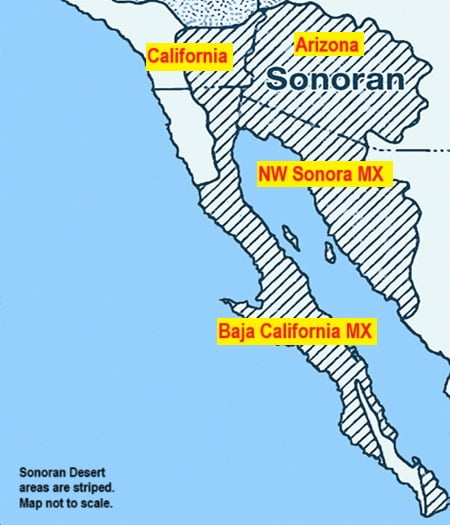
But Sonoran Desert has two rainy seasons. Plants and animals alike (including Tucson Arizona human residents!) look forward to those months.
Why the Sonoran Desert is Special
The Sonoran Desert in Arizona is very special because of its two rainy seasons. Together they provide enough moisture for over 2,000 plant species to survive. Many only grow in the Sonoran Desert, like the giant saguaro (pronounced suh-waa-row).
Geologically and ecologically, the Sonoran Desert ranges across several elevation zones. The lowest areas include desert scrub, with prickly pear cacti, limited numbers of saguaro, and many creosote bushes. As elevations rise, saguaro numbers rise. Even into lower foothills of mountain ranges. Like on the way to Mount Lemmon.
In the summer, the monsoon season goes from about the last week of June into September. That's when the Sonoran Desert in Arizona receives the most rain.
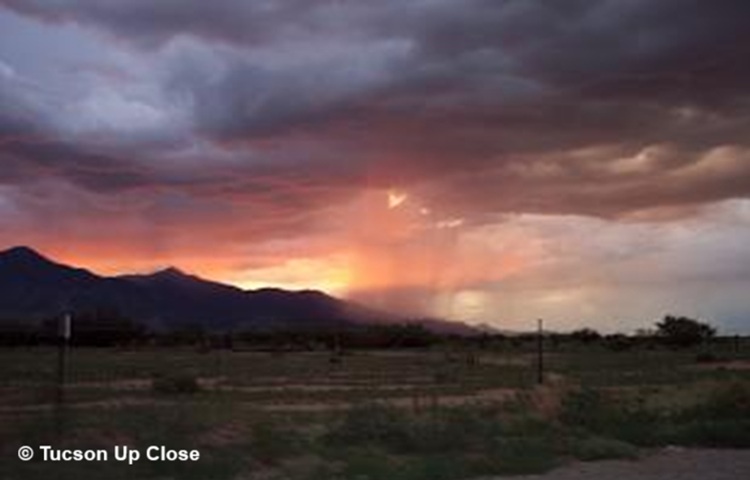
In the winter, storms come in off the Pacific Ocean. They sometimes get over to Arizona. It's variable, as the moisture can rain out over the Sierra Nevada Mountains first. So, total winter rainfall doesn't normally equal monsoon months.
Hurricanes Form in the Pacific Ocean waters south of Baja California. If it steers out of upper-level Trade Winds, it occasionally makes its way through Arizona.
- It can bring some winds, barely reaching tropical storm levels.
- Most of its effects are rainfall. For instance, in mid-October of 2025, Hurricane Priscilla dumped inches of rain in Eloy (north of the Tucson metro area) and parts of Phoenix.
The Sonoran Desert in Arizona has a great assortment of plant life, considering it's a desert environment. According to the National Park Service, the Sonoran Desert is the most diverse desert in the U.S. Besides the myriad plant species like ironwood trees, barrel cacti, and others - It supports hundreds of animal species.
All because of those two main "rainy" times of the year. The variety of interesting fauna, which responds to these rains, is why the Sonoran Desert is sometimes called a "green desert."
Sonoran Desert in Arizona Features Recap
- Size: about 100,000sq.mi. (260,000 km²). Found in Arizona, California, and Mexico.
- Elevation: from sea level to over 4,500 ft.
- Rainfall: 3-15in/75-380mm annually, most during the summer monsoon.
- Climate: hot summers, mild winters, distinct monsoon season.
- Unique Plants: giant saguaro cactus, ocotillo, palo Verde tree.
Tucson & the Sonoran Desert - A Local Connection
The Sonoran Desert in Tucson Arizona presents an environment where the city meets the wild!
The city of Tucson rose up amidst the desert’s domain. When you’re in town, you’re not far from some of the best Sonoran Desert landscapes and wildlife.
No matter where you go around town, the surroundings offer opportunities to know you're in the Sonoran Desert.
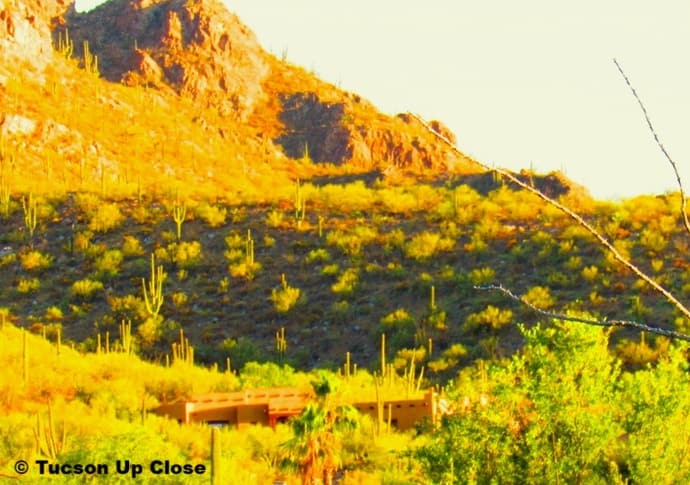 Some Tucson homes are right in the thick of it!
Some Tucson homes are right in the thick of it!Our Suggested Local Hotspots
to Experience the Sonoran Desert
Immerse yourself in these top desert experiences from Tucson to get an authentic taste of the Sonoran Desert in Arizona.
Your Local Tip: All of these are within roughly 30 minutes of downtown Tucson, perfect for half-day or full-day adventures.
- Arizona-Sonora Desert Museum: A living museum combining a zoo 🦉, botanical gardens with desert habitats, and a natural history museum with wildlife exhibits - all in one. We think it's the best starting point for your Sonoran Desert in Arizona experience.
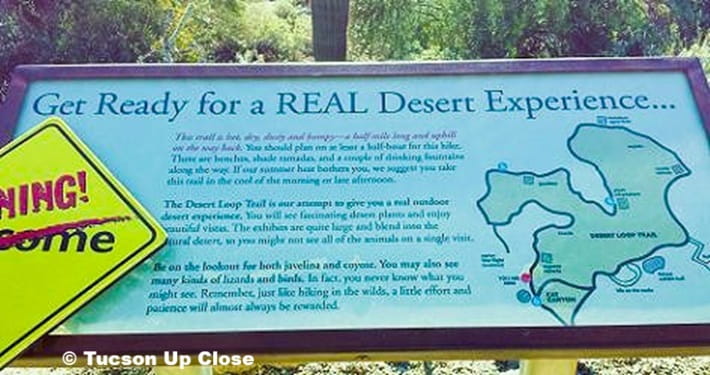 Entry greeting as you go into the depths of the Desert Museum.
Entry greeting as you go into the depths of the Desert Museum.- Saguaro National Park (East & West): Two sections, each with its own features. Both have trails among towering saguaros 🏜️. We love the Western section best, especially for its dense cactus forest.
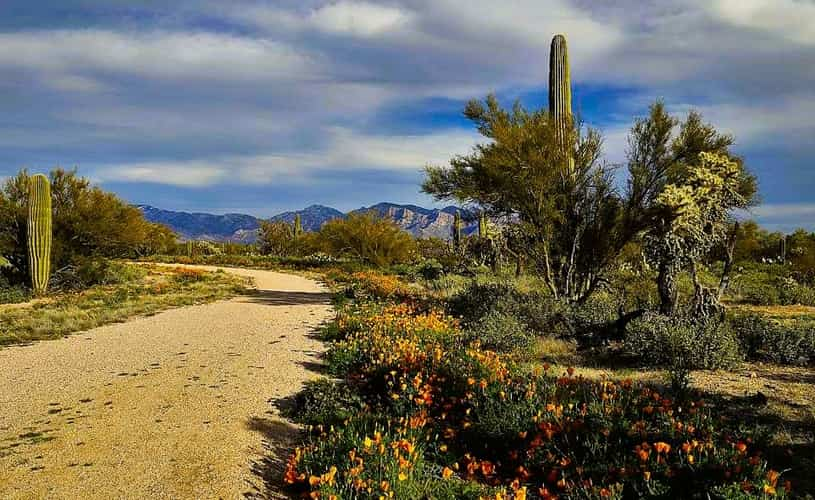 Along a dirt road in Saguaro National Park West, in spring with blooming flowers.
Along a dirt road in Saguaro National Park West, in spring with blooming flowers.- Tucson Mountain Park: Scenic drives 🚙, picnic areas, and wild west flavor. Plus sunset viewpoints 🌄, such as off Gates Pass Road. The park and nearby preserves protect desert terrain in the western side of the city.
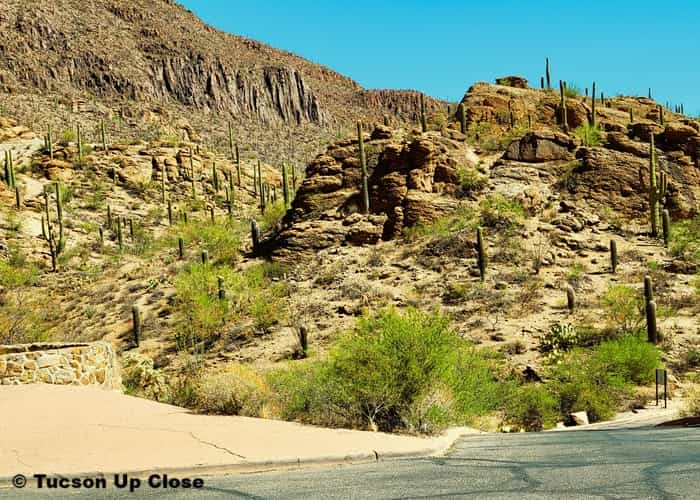 Road heading up to Gates Pass in Tucson Mountain Park.
Road heading up to Gates Pass in Tucson Mountain Park.- Ironwood Forest National Monument: Habitat for rare ironwood trees. 🌳 Not well-known by visitors. Located relatively near Tucson, with outlying desert plant communities. It features the iconic ironwood tree (Olneya tesota).
- Redington Pass: Get panoramic overlooks of desert valleys east of the city. Including views of Tucson, and when over the pass - the San Pedro River Valley.
Yet there are Many More Must-See Places in Tucson!
Flora & Fauna of the Sonoran Desert
The life of the Sonoran Desert in Arizona IS its flora and fauna. We'll show you its distinctiveness.
Iconic Plants of the Sonoran Desert in Arizona
This desert's iconic plant life will show you their notable features 🌿
- Saguaro Cactus (Carnegiea gigantea) grows up to 40 ft. We think it's the plant hallmark of the Sonoran Desert in Arizona. It blooms in May & June, displaying Arizona's state flower.
- Palo Verde is a different kind of tree, because it has green bark. Using added photosynthesis, helping out the work of the tiny leaves. We were fascinated the first time we saw one! Two species are native to the Sonoran Desert in Arizona.

- Ocotillo (Fouquieria splendens) is a shrub (pronounced oh-ko-tea-oh). Look at a rocky Sonoran Desert hillside, and you're bound to see them. In the spring, each tall spiked stem is topped by stand-out orange flowers.
- Cholla Cacti (pronounced choy-uh) are something to be aware of on desert hikes. They're quite prickly along their stems. They're often seen in bunches, with multiple species. Their yellowish flowers fruit from desert pollinators.
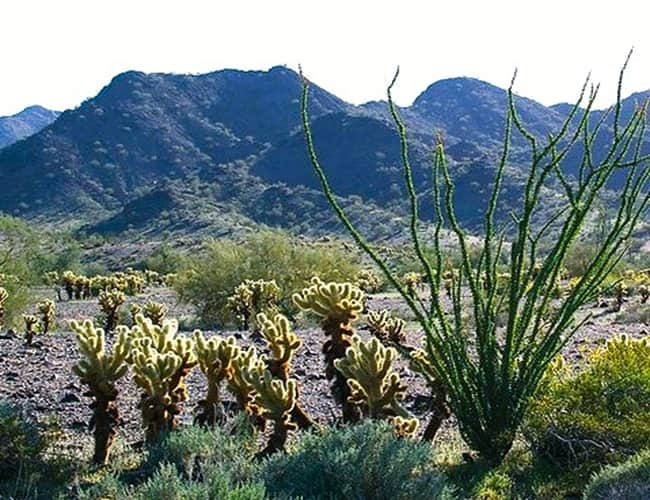 Bushy looking (they're all spines) Cholla cacti on left, ocotillo sprouting leaves on right.
Bushy looking (they're all spines) Cholla cacti on left, ocotillo sprouting leaves on right.- Mesquite Trees provide shade to nearby plants. When growing well their crown spreads out thickly. There are multiple species. They often grow in grove-like stands.
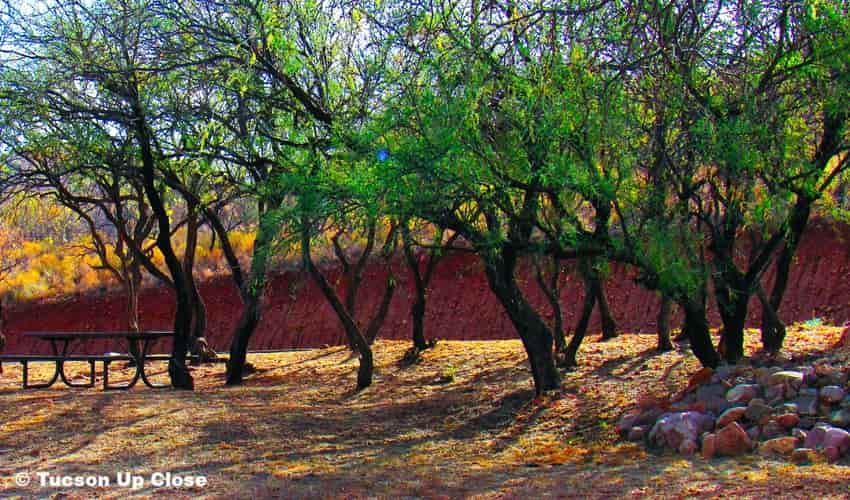 Picnic area being shaded by mesquite trees.
Picnic area being shaded by mesquite trees.- Ironwood Trees are a keystone species. Their bunched crown provides shady shelter that helps young desert plants survive in the harsh environment. Nicknamed a “Nurse Plant” for that reason. Young saguaros are a major example of desert plants that need nursing.
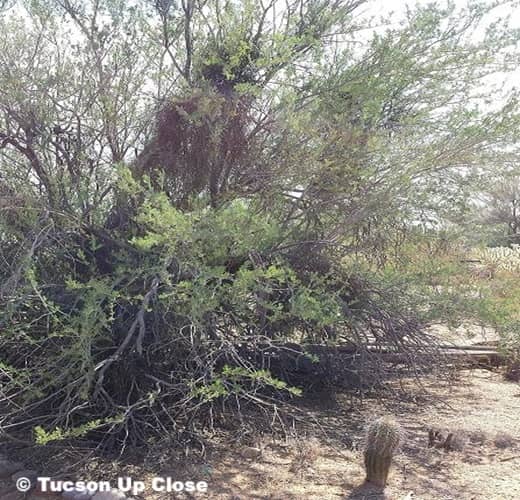 Wild branches of an ironwood tree nursing a baby saguaro cactus.
Wild branches of an ironwood tree nursing a baby saguaro cactus.All these plants have one or more adaptations to do well in their arid circumstances.
- They'll have very deep or spread-out roots - sometimes both.
- Their tissues are able to store water.
- Their growth spurts and flowering are typically timed in sync with summer rains.
Wildlife of the sonoran desert in arizona
Many interesting animals can be seen in Tucson's Sonoran Desert.
- Mammals: javelina, coyote, bobcat, mule deer, desert cottontail
- Birds: Gila woodpecker, cactus wren, Harris’s hawk, roadrunner, hummingbirds
- 🐦🕊️ According to the National Park Service, over 350 species of birds have been recorded in the Sonoran Desert.
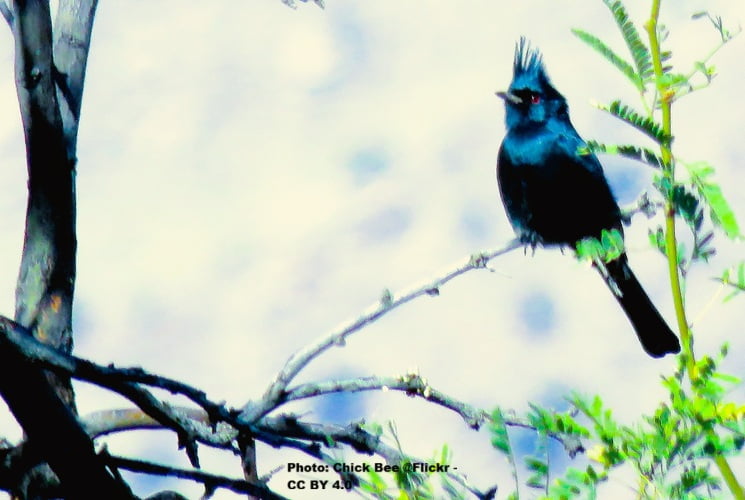 This male Phainopepla is known to regularly visit Sabino Canyon
This male Phainopepla is known to regularly visit Sabino Canyon- Reptiles & Amphibians: desert tortoise, rattlesnakes, horned lizards, toads
- Prime Pollinators: bats, hummingbirds, bees. Vital for cactus blooms
- 🦇🐝Species Adapt: By living a nocturnal life. Or are active during twilight and just before sunrise (called crepuscular).
Desert animal species rely on microhabitats to survive heat extremes. They crawl into rock crevices, huddle down in washes, use underground tunnels, and/or look for shaded outcrop rock ledges. See more of the Wildlife Living in the Sonoran Desert in Arizona.
🦊 Desert Wildlife Fun fact: The saguaro cactus’s white flowers bloom at night to entice pollination by bats. The resulting bloom stays open throughout the following day.
Conservation, Challenges & Threats
🌍 Desert Conservation & Why It Matters
The Sonoran Desert faces challenges.
Urban sprawl keeps creeping in, gobbling up natural desert lands. Rising temperatures and drought (yes a desert can suffer drought = less than normal rainfall averages) affect people, animals and plants. Invasive plant species like buffelgrass crowd out native plants.
Local organizations like the Arizona-Sonora Desert Museum and Sonoran Institute and other conservation organizations focus on:
- Research for habitat preservation and restoration.
- Maintaining wildlife corridors between Mountain Sky Islands.
- Public education concerning responsible recreation.
Did you know?
Saguaro National Park’s cactus forests are protected specifically to ensure the saguaro’s long-term survival.
Visiting Tips from Tucson Locals
Figuring out what to expect when visiting the Sonoran Desert in Arizona is good advance planning. You'll want to anticipate the Climate and Weather, as well as know how to manage the area and your stay.
Best Times to Visit & Weather Tips
We'll help you choose the best time to come to Tucson. Here's a seasonal rundown:
- November through March, for cooler temps (65°F/18°C avg). It's the best season for serious hiking, getting outside for exploration. We think these months have some of the nicest times of the year.
- Late October and early May is normally fine. Good time for short non-strenuous hikes or walking downtown. October is when the weather begins cooling down. May is when the weather is heating up.
- February though May is wildflower season the desert. Great time for photography. During these peak months you'll see fields covered with wildflowers like the California poppy. Especially if there were good winter rains. Plus it's the cactus blooming season.
- Late June through September is Monsoon season. The time for powerful thunderstorms with dramatic lightning, heavy rain and likely flash floods (be careful!). 🌦️ We'd recommend July or August for the best monsoon experience.
- June is when you avoid afternoon midday heat (over 100°F/37.8°C). It's the hottest month of the year. Time to center on indoor activities, chillin' at a shaded poolside, or going up a mountain.
Local Pro Tip:
When hiking, start early in the morning (but observe heat warnings!), bring at least 2 Liters of water per person per half-day hike, wear UPF clothing, and check local park alerts for heat precautions before visiting.
Always wear sun protection, like a hat, sun block & sunglasses. Don't underestimate the desert sun!
Tucson Up Close is made possible by readers like you! If you purchase via a link here, we may earn a small commission. At no added cost to you. Thanks for your support! Learn more>
Exploring the Sonoran Desert from Tucson AZ
Our visitor tips for the Sonoran Desert in Arizona 🌵are designed to help you have a smooth trip in Tucson.
✅ Begin at the Desert Museum for your Sonoran Desert orientation. Next day visit Saguaro National Park West to go deeper.
✅ When outdoors, take water, hat & sunscreen. Wear sturdy shoes. Bring binoculars and plant/animal ID guides (or apps).
✅ When hiking, stay on marked trails. Desert soil and ground surface crust can be fragile. Avoid getting lost (it happens)!
✅ Respect desert etiquette: do not disturb plants or wildlife. Carry out trash.
✅ Don’t pick or touch cacti; many are protected species. Plus some may use their defenses on you!
✅ Enjoy sunrise or late afternoon to sunset hikes for cooler temps and softer light. Great for photography!
✅ Use Guided Tours, interpretive trails or Guided Horseback Riding to deepen understanding.
FAQ for Tucson's Sonoran Desert in Arizona
Where is the Sonoran Desert located in Arizona?
Where is the Sonoran Desert located in Arizona?
The Sonoran Desert covers the southern third of Arizona (and parts of California), stretching south into Mexico. Tucson lies within the desert’s boundaries.
It also includes Phoenix, Lake Havasu City and Yuma. See More Sonoran Desert Boundaries>
Is Tucson part of the Sonoran Desert?
Is Tucson part of the Sonoran Desert?
Tucson sits at the heart of Arizona’s Sonoran Desert. It's surrounded by stunning national parks, and nature preserves. Provided for all to demonstrate the region’s cactus-filled landscapes and The Unique Wildlife.
What animals live in the Sonoran Desert?
What animals live in the Sonoran Desert?
Common Species are those you may see. Like javelina, coyotes and road runners. There are hundreds of bird species, and birders love parts of the Sonoran Desert for that. See Them All Here>
Those you'll probably not encounter are bobcats and Gila monsters.
Why is the Sonoran Desert unique?
Why is the Sonoran Desert unique?
It’s the only North American Desert with a Climate including two distinct rainy seasons, one in the winter and one in the summer.
Many desert plants have adjusted to take advantage of that rainfall. Because of that, there is a good assortment of plants and animals that do well in the Sonoran Desert.
When is the best time to visit the Sonoran Desert in Tucson?
When is the best time to visit the Sonoran Desert in Tucson?
November to March offers comfortable hiking weather. Spring (Feb–Apr) brings wildflowers and cactus blooms. We've Got Our Local Step by Step Tips Here>
Is the Sonoran Desert hotter than other U.S. deserts?
Is the Sonoran Desert hotter than other U.S. deserts?
When analyzing average summer highs, the Sonoran Desert is among the hottest, especially in lower elevation zones near the Colorado River, which can reach 118°F/48°C.
Summer temperatures routinely exceed 104°F/40°C. See More Climate Details>
Isolated record highs can occur elsewhere in other Arizona deserts.
- The Chihuahuan Desert's summer daytime highs in lower elevations get to 90-104°F.
- The Mojave Desert averages around 97-105°F. But can reach up to 118°F at times.
Thus the Sonoran Desert stands out as the hottest U.S. desert overall.
References:
- Sonoran Desert Network Ecosystems - National Park Service. nps.gov/im/sodn/ecosystems.htm
- Visitor Center Information - Saguaro National Park (U.S. National Park Service). nps.gov/sagu/ planyourvisit/visitor-center-information.htm
- Arizona-Sonora Desert Museum, Tucson, AZ - desertmuseum.org
- Ironwood Forest National Monument - en.wikipedia.org/wiki/
- Redington Pass - wikipedia.org/wiki/Redington_Pass
- DeRoche, E. (2021, May 25). Do hurricanes ever hit the West Coast of the U.S.? CompuWeather. compuweather.com/do-hurricanes-ever-hit-the-west-coast-of-the-u-s/


